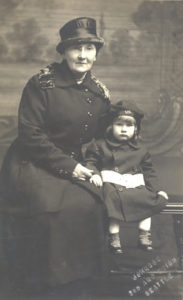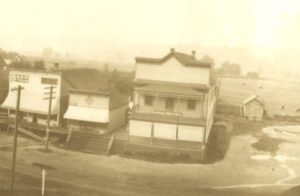A short story about the life of one of the Stillaguamish Valley’s early Pioneers.
By A. Loren Kraetz

Anna Blacken Swanson was born Jan. 6, 1865 in Surendalen Khristiansund, Norway. Her parents, Ole and Maret (Toalge) Blacken, had a small farm, but like so many other Norwegians at that time, had heard of the alluring riches of America and dreamed of a chance for a better life in the new world. This meant leaving their home, friends and loved ones, with the probability of never seeing any of them ever again.
Anna was three years old when she sailed from Norway with her parents on a frigate headed for Quebec, Canada their final destination. Four hundred passengers, all Norwegians, paid $15 for their passage. Each person was allowed two quarts of water a day. They took all food necessary for the entire journey. Fifty-three days were spent on the ship without seeing land. During the crossing eleven passengers were buried at sea. The ship had a stormy crossing, one storm lasting three weeks. Passengers were forced to hang onto their bunks, and throughout the storm they could not use their deck stoves (which were bolted to the deck) except at rare intervals. Heartfelt prayers of thanks for deliverance were given as the ship docked.
The immigrant train waited to transport them farther to their destination. Jolting from side to side, they endured thick black coal smoke, belching from the tugging steam engine. These were merely freight cars with board benches fixed along the sides.
On these, they sat, slept, and ate for the duration. On August 20th, 1868 they finally reached Northport, Michigan, in Leelanau County, where they were to make their new home.
It was here that Ole Blacken built a log cabin and began working in the lumber industry. His daughter Anna began her early education, becoming proficient in English and Norwegian.
As time went by the American dream began to tarnish. Frigid winds of winter, coupled with sub-zero temperatures, and followed by stifling hot summers with unbearable humidity made Michigan less than paradise.
The luring tales of something better on the Pacific coast haunted Anna and her brother John O. Blacken until they could resist no longer.
Marie, boarded a train for Seattle in Washington Territory. Upon arrival they made their way to the wharf, where they booked passage on a steamboat for Florence, Washington on the Stillaguamish River. From Florence they were carried up the river to Norman by Indians standing and propelling by long poles their shovel nosed canoes, which were most efficient in shallow water.
At Norman John had the good fortune of landing a job at McFadden’s logging camp. Anna hired on as camp cook. Growing up in the woods of Michigan, she had learned how to “make do” in the kitchen. Word soon spread of Anna’s savory skills. Quickly she had job offers up and down the river.
At this time logging on the Stillaguamish was in its infancy. There were no steam donkeys until after the railroads came in 1890-91. Logging was done by oxen and horses, mostly along the river banks using six yokes of oxen on a turn of three logs, pulled over puncheon, a “road” of small logs laid side by side, perpendicular to the track. The nearest saw mill was at Utsalady on Camano Island. It was there that ocean vessels could deliver the necessary machinery to erect a saw mill.
It wasn’t long until Anna’s reputation took her up both forks of the river, cooking in makeshift tent kitchens and mess halls. She felt comfortable being poled up and down the river by an experienced Indian canoeman, Jim Harvey, with whom she remained friends until his death.
In 1887 Anna married Charles Carlson of Sweden. They had a son, Elmer, in 1888. Anna continued cooking in the logging camp preparing three meals a day and doing some laundry. She took her seven year old niece, Marie, along to care for her infant son and to keep the native Indian children clear of her cake dough and bag of raisins. Perhaps Marie was the valley’s first playground supervisor!
Most of the early loggers were Scandinavians, and it was common practice at this time for laborers to ask logging foremen, “Who is the cook,” before asking about the wages. With Anna’s Norwegian background, she knew how to satisfy their hungry appetites with familiar food.
After four years of putting up with Charlie Carlson’s weakness for booze, Anna divorced him.
She was goal oriented and had a dream of owning a hotel. With the coming of the Great Northern Railway in Silvana in 1890-91, she saw the opportunity of having a successful business of her own. She had culinary skills, a command of English, Norwegian and Swedish, as well as a reputation of being honest and compassionate.
In 1892 she married her second husband, Neal Swanson, but continued using her skills in the camps.
By 1894 Anna had saved enough money to build a two-storied hotel in Silvana directly across from the Great Northern depot. She offered meals family style for 25 cents and rooms 25 cents single or doubles, 50 cents.
At last she could retire from the hard work of the logging camps and their harsh conditions. The hotel was an instant success. She had a steady stream of railroad men, bolt cutters and mill workers to keep the hotel more than fully occupied. She offered laundry service as well for her boarders.
With all the cooking, washing and room cleaning it required more than her two diligent hands. During this time many young girls also immigrated from Norway. These girls found employment scarce and many became depressed. They had no money to go back home, spoke only Norwegian, and seemed lost in the jungle of virgin timber.
During the ensuing years Anna took many of these young girls under her wing, giving them a job, food, and a place to stay and helping them learn English until they had a chance to gain some self-confidence and independence. Many of these immigrant girls found suitable husbands and spent the remainder of their lives within eyesight of Anna’s hotel in Silvana.
Anna and Neal Swanson had two children, Nina and Arthur. Neal adopted her first son, Elmer. In 1899 Anna suffered the loss of her husband of seven years when he fell from the Great Northern Railway trestle and died. With renewed determination, she set about raising three children and running her hotel.

Two years later in March of 1901 another huge set back: Ewing’s general store caught fire, burning Anna’s hotel and the Peterson’s residence. In spite of the fact that Silvana had little water and no fire department, much of the hotel’s contents were saved.
With some insurance money Anna quickly bought lumber, and as soon as the embers cooled she rebuilt the hotel. Many of her boarders took a leave from the woods to help rebuild their home. In two months the hotel was back in full swing.
Conditions were just looking good when seventeen months later, on Aug. 23, 1902, a second devastating fire burned her new hotel, Ewing’s new general store, Peterson’s new home and two additional business houses. The fire of unknown origin started in a woodshed at the rear of Anna’s hotel. Once again the residents of Silvana came running and saved most of the hotel’s contents.
Now for the third time Anna began construction at once for a new building, this one being larger than the first two. By winter the hotel was up and running once again. This time she maintained a vacant lot on either side as a fire break.
As the valley gave way to dynamite, grubhoe and guts, many large prosperous farms developed around Silvana. Often farmers who employed large crews for haying, threshing, silo filling and pea vining would treat their crews to a tasty noon feast in the hotel’s large dining hall.
Anna was always there to meet special needs. She continued running the hotel with no further crises until 1925, when after 31 years of service to the community she decided to hang up her apron and sold the hotel to the “Sons of Norway” for their lodge building, renamed “The Viking Hall.”
The lodge removed the partitions on the upper story and made it into a dancehall with a stage at one end. The lower portion continued as a dining hall and office space.
During the next 27 years the hall was frequently used for smorgasbords and Scandinavian dances. By 1952 it began to sway when 150 or more Norwegians began to dance the schottische and polka. In the interest of safety it was taken down and replaced with the present Viking Hall.
Upon retirement at age 60 Anna built a small house at the west end of Silvana and enjoyed another 20 years of traveling, visiting and entertaining old friends. She stayed active in the “Daughters of Norway, “and founded the Camilla-Collett Lodge No. 25 in Silvana.
With Anna’s passing Jan. 1, 1946, just short of her 81st birthday, many heads were bowed in respect. Anna was known throughout the district for her hospitality and generosity. All her life she quietly performed many acts of charity, and it was said no worthy person was ever denied her assistance. The hardships of frontier life were cheerfully born by this witty, neighborly woman whose kindness and sympathy in the sickness and sorrow of others was typical of her early days. She was a woman of energy and talent, who was very influential in the early development of the social and cultural aspects of the Silvana community, leaving it a far better place than she found it sixty years earlier.
Note: Anna’s brother, John O. Blacken, became proprietor of a hotel and general store in Lakewood, Washington. Her niece, Marie (great-aunt of the author), became the farm wife of Alex Spoerhase and lived to become a centenarian.
Reference credits to:
The Arlington Times
Wilma Warner (grand-niece)
Mildred and Margaret Spoerhase (grand-nieces)
© 2010 Loren Kraetz, All Rights Reserved
